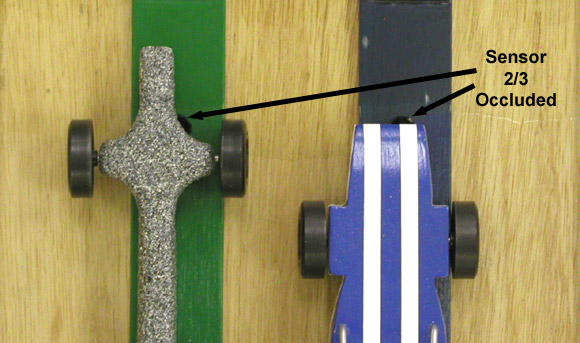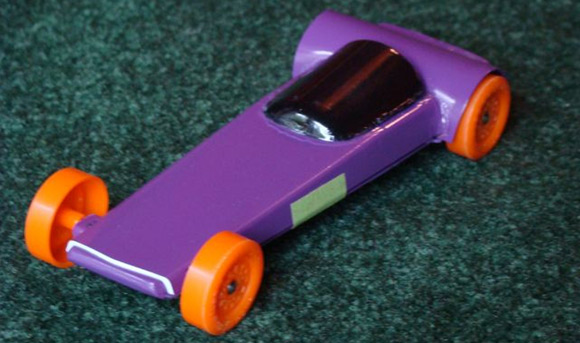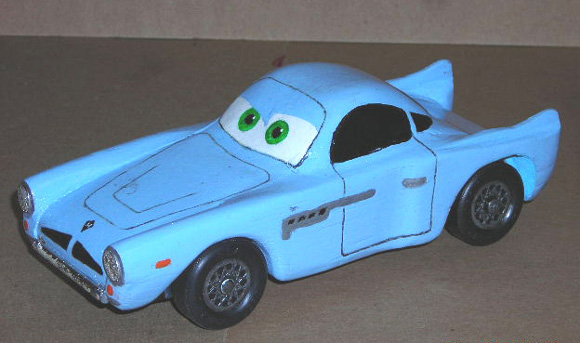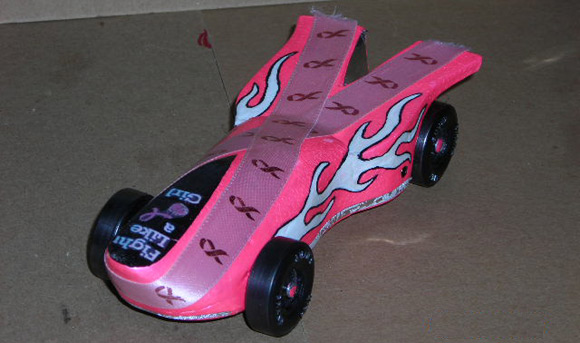– Feature Article – Eliminating Race Variation
– Pinewood Derby Car Showcase
– Q&A
Feature Article
Eliminating Race Variation
By Randy Davis
Have you ever looked at heat times for pinewood derby cars? If your event uses an electronic timer, then the heat times are available and can provide important insight on race performance.
Quite often the heat times vary considerably, while in some cases the heat times are quite close. This difference in heat times is sometimes called “race variation”. Today we will look at what causes race variation, identify what can and what cannot be controlled, and then suggest ways to minimize race variation.
Uncontrollable Factors
Some factors that cause heat variation cannot be directly controlled by the car builder, however, in some cases they can be minimized by adjusting the car design. The main factors in this category are: Lane Variation, Staging Variation, and Finish Line Variation.
Lane Variation
Under racing conditions, race variation will be introduced due to lane differences. On many tracks there are fast lanes and slow lanes. This lane variation can be due to defects in the track surface and lane guides, and/or warping of the track due to poor setup, improper storage, or exposure to heat or moisture. Although the race participant cannot directly control these factors, lane variation can be minimized by:
- Setting the balance point of the car – If the track is known to be rough or warped, then setting the balance point to be less aggressive (more stable), will help the car to stay on a more true line as it runs down the track.
- Setting the alignment – As long as the track guides are reasonably smooth, setting the car to rail-ride will minimize variation because the car will hold a straight line. Also, when rail-riding, the balance point of the car can generally be set more aggressive to improve performance.
- Running on three wheels – keeping one wheel off the ground reduces track contact, which can help minimize variation.
Staging Variation
Variation in heat times is also introduced by differences in the way the car is staged from heat to heat. If the car owner places their own car on the starting line, then variation can be minimized by staging the car consistently. But if a race official stages the car, then little can be done (other than to make sure the official knows which end of the car is the front end!)
Finish Line Variation
The finish line can also introduce variation. If the front of the car is quite narrow, then the point at which the finish line sensor is tripped can vary depending on whether the car is centered, or is shifted left or right as it passes the sensor (see Figure 1). To minimize this source of variation, make sure the front of the car is a minimum of 1/2 to 3/4 inch in width.1

Controllable Factors
There are many factors that can cause race variation which can be controlled by careful car design and construction. Some of these which have already been mentioned are weight position, alignment, and 3 versus 4 wheels on the ground. Additional factors include: precision components, better fitting components, aerodynamics, and lubricant choice.
If there are no limits on components and if the track is very smooth, then heat variation can virtually be eliminated. In an experiment using needle axle outlaw wheels, and Krytox 100 lube, the heat deviation was measured at .0016 seconds (standard deviation).2 But even with more stock components, the heat deviation can be kept to .0030 seconds (standard deviation).3 So, proper design and construction can make a huge difference in heat variation.
Precision Components
Regardless of the kit type, stock wheels and axles are not perfect. Wheels can be out of round, have a left-to-right wobble, and/or out of round bores. Axles also have defects and variation. To minimize heat variation, the wheels are axles should be as accurate as possible. Some possible remedies include:
Wheels
- Truing wheels on a lathe or with a Pro-Wheel Shaver XT.
- Measuring wheels and using the most accurate ones.
- Polishing the bore of the wheel.
- Purchasing trued wheels.
Axles
- Polishing axles to a high shine.
- Beveling the axle head.
- Grooving the shaft.
- Purchasing accurate replacement axles.
Better Fitting Components
When wheels and axles have a sloppy fit, then the wheels have an opportunity to move in undesirable ways in response to track defects. So, to minimize heat variation, the wheels and axles should be sized to fit. This may not be possible due to rule restrictions, but if allowed, size the axle to be no more than 5 thousandths of an inch smaller than the bore. After-market axles with larger diameters are available for BSA and other wheels with a sloppy wheel/axle fit.
Aerodynamics
Low-profile cars and narrow wheels both reduce aerodynamic drag and turbulence. Although these are minor factors, some improvement in heat variation can be achieved by reducing the cross-section of the car and by using fenders.
Lubricant Choice
Another possibility for reducing heat variation is the lubricant choice. Although I do not have firm results, it appears that Krytox 100 produces slightly less heat variation than graphite.
Conclusion
So, if you want to improve heat variation – and performance as well – consider implementing some of the options discussed above. You will find that your car is more consistent, and consistently faster than most (if not all) of the entrants in your race.
1For more information on finish line variance, see Is Your Finish Line Providing Accurate Results?
2See Solenoid Start Gate: Are Races More Consistent? Although this article is not specifically on reducing race variation, it does show how consistent cars can run with precision components.
3See Cheater Bars – Do They Work? Again, this article is not on reducing race variation, but it does show how consistent cars can run with stock components.
Pinewood Derby Car Showcase
CUDA – James White
This car named “CUDA” was built for my grandson’s (Aaron Shain’s) 2013 pinewood derby races. The rear fenders are made from a portion of the plastic bottle that the BSA wheels come in, and the cockpit canopy is made from a slice off the side of a small shampoo bottle.
Finn McMissile – Caleb Tachick
At my son Caleb’s first Awana Grand Prix, he and Finn held their own most of the day, but ended up around 6th or 7th. But since it was our first year, the real goal was the design award. He came home with 2nd place; he would have had first but his sister’s Cancer Survivor Ribbon car took first. They never raced each other until after the event when the track was open for fun runs. They ran neck and neck. Finn McMissile is shown here with the BSA wheels we swapped over to for the Home Depot race a month later, where he took 4th place — not bad for a full bodied car.
Cancer Survivor Ribbon – Kailyn Tachick
Here is my daughter Kailyn’s 1st place Awana car in the design category. This car was in honor of her grandma, who within the last year underwent treatment and surgery for cancer. We thank the Lord she is doing OK today. We did not hollow out the nose (my first year to build), but did incorporate rear fenders, reduced midsection as on supersonic jets, a concave tail end like a Shelby Daytona coupe, and speed axles from Maximum Velocity. After losing her first heat(in a double elimination race format), she continued to terrorize the loser’s bracket to within a few heats from the end!
Q&A
Do you have any advice on cutting an axle groove on a block with pre-drilled axle holes? Could I just take a hacksaw and cut a groove between the axle holes?
I wouldn’t cut slots into a block with drilled axle holes unless your rules specifically state that axle slots are required. If you must have slots, then put two hacksaw blades together (most hacksaw frames will hold two blades), and cut down to the axle holes. If the blades don’t stay together use one or more binder clips to hold them together.
I am interested in both the Pro-Axle Guide and Pro-Body Tool, and was wondering which you have found is more effective? Both seem as if they would work but I didn’t know if one was more reliable.
If you are using axle slots, the Pro-Axle Guide will help you insert the wheels into the slots. But if the slots are not perfectly straight, then the axles will be crooked.
To get more accuracy, the Pro-Body tool will let you drill new axle holes, or put pilot holes in the axle slots. This will tend to correct slightly irregularities in the axle slots.
How does using lighter wheels help make the car faster? Common sense would indicate the total weight of the car would be the deciding issue here. So if I use lighter wheels, but ALL the parts together weigh 5.0 ounces, isn’t it a zero sum game?
Lighter wheels generally improve the speed of the car because lighter wheels take less energy to start rolling. So cars with lighter wheels tend to jump ahead as the starting gate opens. On normal length tracks, they can keep the lead through the finish line. If the track is exceptionally long, then cars with heavier wheels may catch up, as heavier wheels tend to roll longer.
Want Answers?
Do you have a pinewood derby-related question? If so, e-mail us your question.We answer all questions by e-mail, but not every question will appear in the Q&A section of the newsletter.
Back Issues
Are you a new subscriber, or have you missed some of the previous newsletters? Don’t miss out; all of the issues for Volume 5 through Volume 17 are posted on our web site.
Newsletter Contributions
We welcome your contributions. If you would like to contribute an article, a web site review, a speed tip, or a pinewood derby memory, please e-mail us.
Subscription Information
The Pinewood Derby Times is a free e-newsletter focused on pinewood derby racing. It is published biweekly from October through March.
If you haven’t already done so, please forward this issue to your pinewood derby friends. But please don’t subscribe your friends. Let them decide for themselves. Thanks.
If this newsletter was forwarded to you, why not subscribe to receive this newsletter. There is no cost, and your e-mail address is safe, as we never sell or share our distribution list.
To subscribe, send a blank e-mail to
[email protected]
You will receive a confirmation e-mail. Reply to the confirmation e-mail and you will start receiving the Pinewood Derby Times with the next issue.
Randy Davis, Editor, Pinewood Derby Times
E-Mail: [email protected]
(C)2018, Maximum Velocity, Inc. All rights reserved. Please do not reprint or place this newsletter on your web site without explicit permission. However, if you like this newsletter we grant permission, and encourage you to e-mail it to a friend.
Maximum Velocity disclaims any personal loss or liability caused by utilization of any information presented in this newsletter.
The Pinewood Derby Times is not specific to, and is not affiliated with the Boy Scouts of America, YMCA, Awana, or any other organization.
(R)Maximum Velocity is a registered trademark of Maximum Velocity, Inc.
(R)Pinewood Derby is a registered trademarks of the Boys Scouts of America.
(R)Awana is a registered trademark of Awana Clubs International.
All other names are trademarks of their respective owners.



